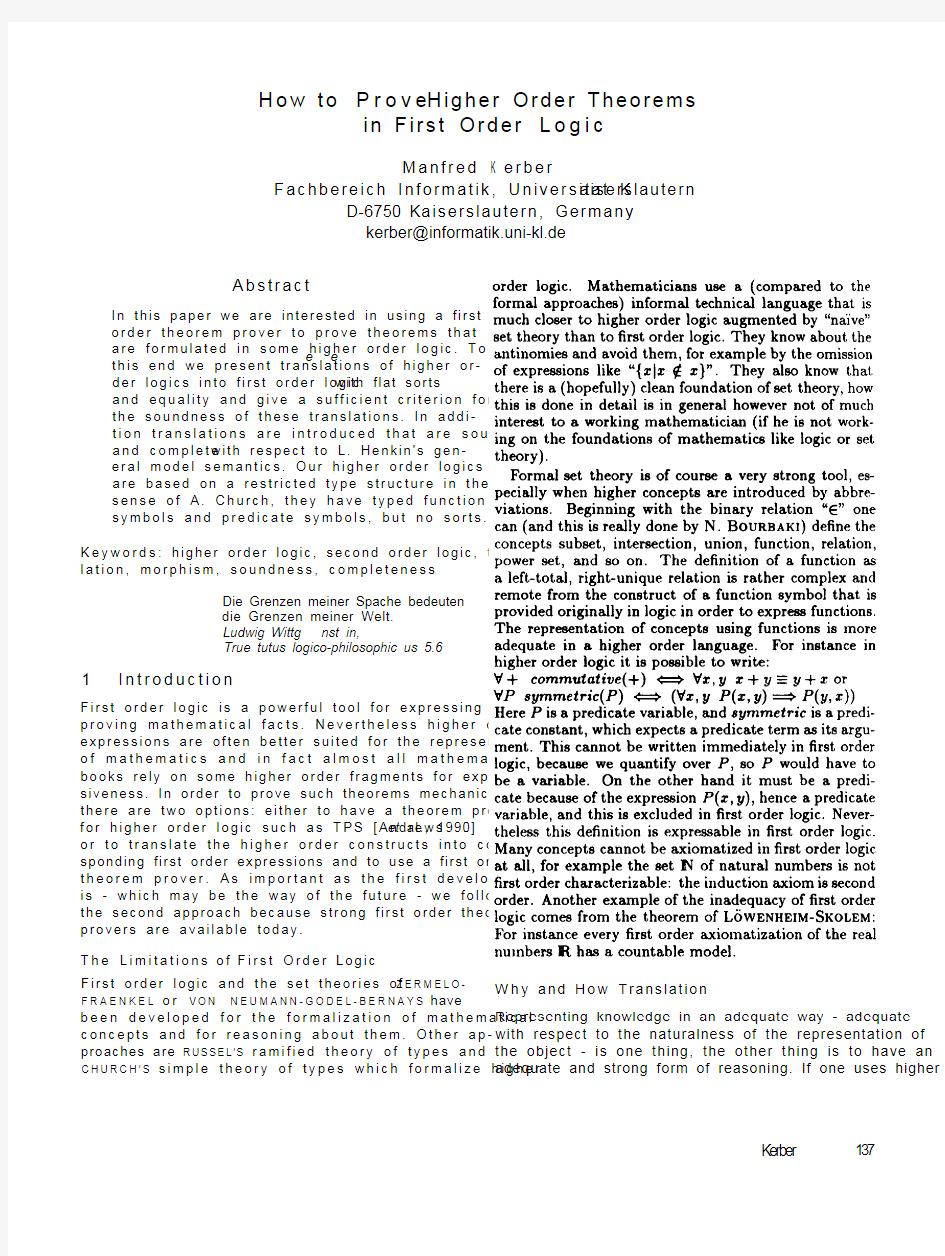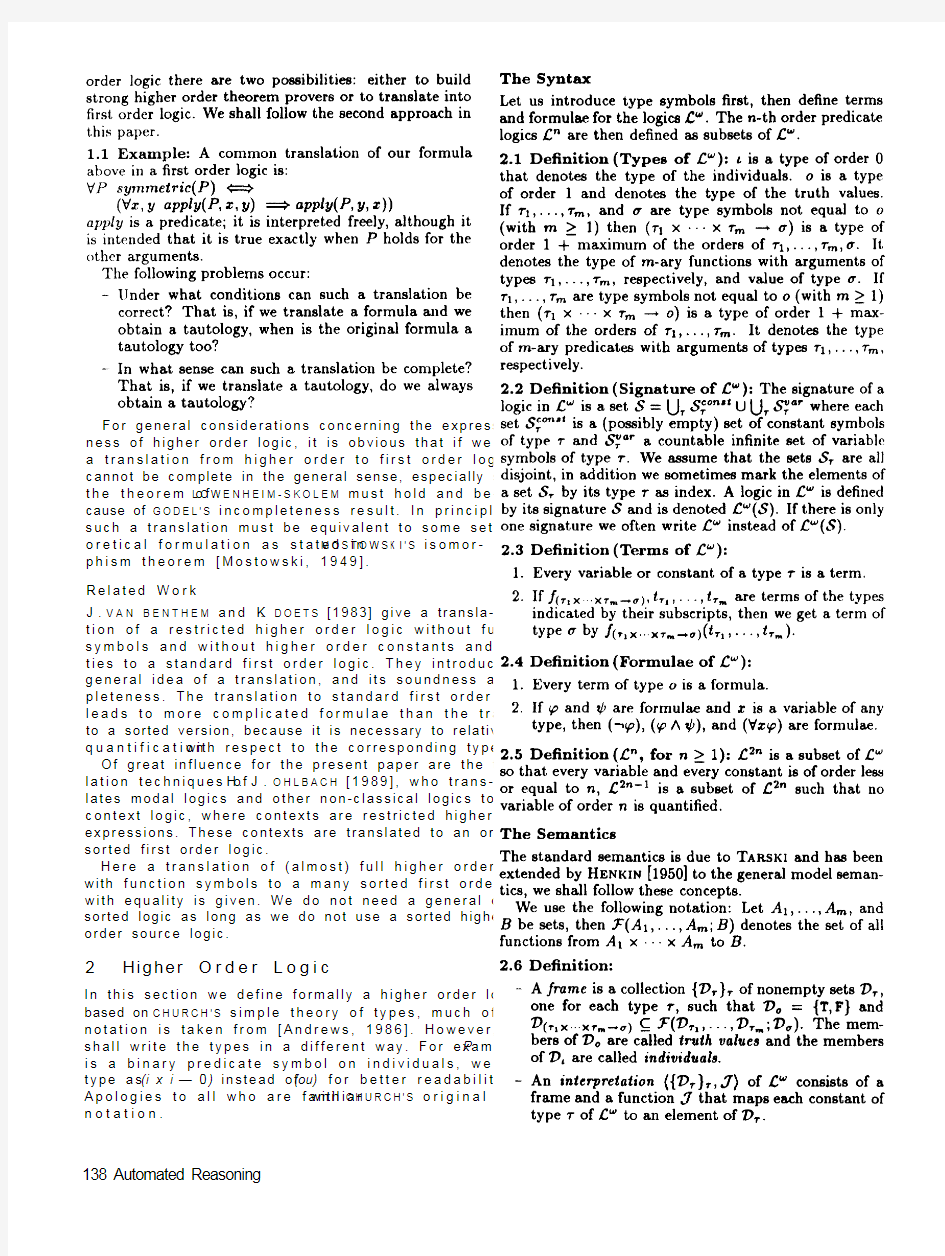How to Prove Higher Order Theorems Abstract in First Order Logic


H o w t o Prove H i g h e r O r d e r T h e o r e m s
i n F i r s t O r d e r Logic
M a n f r e d K e r b e r
Fachbereich Informatik, Universitat K aiserslautern
D-6750 K aiserslautern, Germany kerber@informatik.uni-kl.de A b s t r a c t
In this paper we are interested in using a first order theorem prover to prove theorems that are formulated in some higher order logic. To
this end we present translations of higher or-der logics into first order logic w i t h flat sorts and equality and give a sufficient criterion for the soundness of these translations. In addi-tion translations are introduced that are sound and complete w i t h respect to L. Henkin's gen-eral model semantics. Our higher order logics are based on a restricted type structure in the sense of A. Church, they have typed function symbols and predicate symbols, but no sorts. K e y w o r d s : higher order logic, second order logic, trans-lation, morphism, soundness, completeness
Die Grenzen meiner Spache bedeuten die Grenzen meiner Welt. Ludwig Wittg e nst e
in,
True tutus logico-philosophic us 5.6
1 I n t r o d u c t i o n
First order logic is a powerful tool for expressing and proving mathematical facts. Nevertheless higher order expressions are often better suited for the representation of mathematics and in fact almost all mathematical text books rely on some higher order fragments for expres-siveness. In order to prove such theorems mechanically there are two options: either to have a theorem prover for higher order logic such as TPS [Andrews e t al., 1990] or to translate the higher order constructs into corre-sponding first order expressions and to use a first order theorem prover. As important as the first development is - which may be the way of the future - we follow the second approach because strong first order theorem provers are available today.
T h e L i m i t a t i o n s o f F i r s t O r d e r L o g i c
First order logic and the set theories of Z E R M E L O -F R A E N K E L or V O N N E U M A N N -G O D E L -B E R N A Y S have been developed for the formalization of mathematical concepts and for reasoning about them. Other ap-proaches are R U S S E L 'S ramified theory of types and C H U R C H 'S simple theory of types which formalize higher
W h y a n d H o w T r a n s l a t i o n
Representing knowledge in an adequate way - adequate with respect to the naturalness of the representation of the object - is one thing, the other thing is to have an adequate and strong form of reasoning. If one uses higher
Kerber
137
For general considerations concerning the expressive-ness of higher order logic, it is obvious that if we find a translation from higher order to first order logic, it cannot be complete in the general sense, especially since the theorem of L O W E N H E I M-S K O L E M must hold and be-cause of G O D E L'S incompleteness result. In principle such a translation must be equivalent to some set the-oretical formulation as stated in M O S T O W S K I'S isomor-phism theorem [Mostowski, 1949].
R e l a t e d W o r k
J. VAN B E N T H E M and K.D O E T S [1983] give a transla-tion of a restricted higher order logic without function symbols and without higher order constants and identi-ties to a standard first order logic. They introduce the general idea of a translation, and its soundness and com-pleteness. The translation to standard first order logic leads to more complicated formulae than the translation to a sorted version, because it is necessary to relativize quantification w i t h respect to the corresponding type.
Of great influence for the present paper are the trans-lation techniques of H. J.O H L B A C H [1989], who trans-lates modal logics and other non-classical logics to a context logic, where contexts are restricted higher order expressions. These contexts are translated to an order sorted first order logic.
Here a translation of (almost) full higher order logic w i t h function symbols to a many sorted first order logic with equality is given. We do not need a general order sorted logic as long as we do not use a sorted higher order source logic.
2 H i g h e r Order Logic
In this section we define formally a higher order logic based on C H U R C H'S simple theory of types, much of the notation is taken from [Andrews, 1986]. However, we shall write the types in a different way. For example if P is a binary predicate symbol on individuals, we write its type as (i x i — 0) instead of (ou) for better readability. Apologies to all who are familiar w i t h C H U R C H'S original notation.
138 Automated Reasoning
Kerber 139
140 Automated Reasoning
5.6 R e m a r k: One might wonder why we proposed a suf-
ficient criterion for the soundness of translations, when
we have a translation that is sound and complete and
hence could be used always. However in a concrete situ-
ation it can be better not to translate into the full sound
and complete formulae, because the search space may become too big. It would not be a good idea to add
the extensionality axioms if they are not really needed.
In addition we can prevent instantiation if we translate certain constants not by an apply or if we use different
apply functions or predicates although we could use the same. On the other hand the completeness result guar-
antees that we can find a translation at all. Which one
we choose may be very important for the theorem prover
to find a proof. Whereas the extensionality axioms are relatively harmless, for re ally highe r orde r theorems it is necessary to add so-called comprehension axioms (com-
pare [Andrews, 1986, p. 156]) in order to approximate
weak semantics to strong semantics. For many theorems
these axioms are not necessary, for the others one must choose the axioms very carefully, otherwise the first or-
der theorem prover will get a search space that is too
big. It is the advantage of higher order theorem prov-
ing compared to our approach, that there one does not
need these axioms (for the prize of the undecidability of unification). In the appendix we give an example of a theorem, where a comprehension axiom is necessary.
6 Summary and Open Problems
In the sections above we introduced the basic machinery
for translating higher order formulae to first order logic.
Kerber 141
We introduced a sufficient criterion for the soundness of such a translation, namely that it has to be an injective quasi-homomorphism. Then we gave a complete trans-lation for the restricted higher order language.
In the full version of the paper [K erber, 1990] we gen-eralized the results to logics with equality. An interest-ing and useful generalization would be to a higher order sorted logic. Then the first order logic should have a sort structure at least as powerful as that of the higher order source logic. The results should be transferable although the formal treatment can become strenuous. A c k n o w l e d g e m e n t
I like to thank A X E L P R A C K L E I N for many discussions and thorough reading of a draft and J O R G SlEK MANN for his advice that resulted in numerous improvements.
References
[Andrews e t ai, 1990] Peter B. Andrews, Sunil Issar,
Dan Nesmith, and Frank Pfenning. The TPS theo-rem proving system. In M.E. Stickel, editor, Proc. of
the 10th CADE, pages 641-642, K aiserslautern, Ger-many, July 1990. Springer Verlag, Berlin, Germany.
L N A I 449. [Andrews, 1986] Peter B. Andrews. An Introduction to Math e matical Logic and Typ e Th e
ory: To Truth through Proof. Academic Press, Orlando, Florida, USA, 1986. [Benthem and Doets, 1983] Johan van Benthem and Kees Doets. High e r Orde r Logic, volume I: Elements of Classical Logic of Handbook of Philosophical Logic, D. Gabbay, F. Gu e nthn e
r, Edts., chapter 1.4, pages 275-329. D.Reidel Publishing Company, Dodrecht, Netherlands, 1983. [Henkin, 1950] Leon Henkin. Completeness in the the-ory of types. Journal of Symbolic Logic, 15:81-91, 1950. [Kerber, 1990] Manfred K erber. How to prove higher order theorems in first order logic. SEK 1 Report SR-90-19, Fachbereich Informatik, Universitat Kaiserslau-tern, K aiserslautern, Germany, 1990. [MKRP, 1984] K arl Mark G Raph. The Markgraf K arl Refutation Procedure. Technical Report Memo-SEK I-MK-84-01, Fachbereich Informatik, Universitat K ai-serslautern, K aiserslautern, Germany, January 1984. [Mostowski, 1949] Andrzej Mostowski. An undecidable arithmetical statement. Fundam e nta Math e matica e , 36:143-164, 1949. [Ohlbach, 1989] Hans Jiirgen Ohlbach. Context logic. SEKI Report SR-89-08, Fachbereich Informatik, Uni-versitat K aiserslautern, K
aiserslautern, Germany, 1989.
Appendix
We present an MK RP-proof of C A N T O R 'S theorem that the power set of a set has greater cardinality than the set itself. We use the formulation of [Andrews, 1986, p.184]. A comprehension axiom is necessary. We write t as I, o
as 0, — as T, a "^4
-*))" as A [I T [I T 0]], and so on.
142
Automated Reasoning
